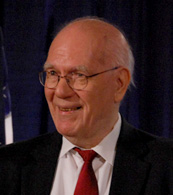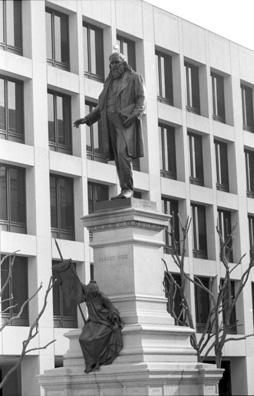 Fidelio, Vol.II,No, 2. Summer 1993 |
FIDELIO MAGAZINE
|
|
Lyndon H. LaRouche, Jr. Responds to C. Fred Kleinknecht: A Question of Historical MethodOn Feb. 1, 1993, C. Fred Kleinknecht, “Sovereign Grand Commander of the Scottish Rite of Freemasonry Southern Jurisdiction of the United States,” issued a position paper attacking Lyndon LaRouche as the director of a nationwide campaign for the removal of the Albert Pike statue erected by Mr. Kleinknecht’s organization. The seventeen-page Kleinknecht paper attempted to rebut the evidence that Pike was the co-founder of the Ku Klux Klan while also the Commander of Kleinknecht’s Freemasonic group. Kleinknecht also asserted that the post-Civil War KKK was not a very bad organization. The Pike statue stands on Federal land at Judiciary Square in Washington D.C. and is maintained at federal expense. The city councils of Austin, Buffalo, Birmingham, Newark, New Orleans, and Tuskegee have requested the Federal government to remove the statue as offensive to mankind. The following response to the Kleinknecht paper was released by Mr. LaRouche on Feb. 21, 1993. |
How Albert Pike Proved Himself a KKK Criminal
I have been made aware of attacks on me, in your purported rebuttal of the documentation showing that Gen. Albert Pike was the spiritual and actual founder or co-founder of the original Ku Klux Klan, in addition to his functions as an intelligence officer of the treasonous Confederacy, and in addition to his close liaison with Lord Palmerston’s Italian collaborator, Giuseppe Mazzini.
 Lyndon LaRouche |
This is to inform you, not only that your defense of Pike from his affiliation with the original Ku Klux Klan, the outgrowth in fact of the earlier Knights of the Golden Circle, is false; but that there are several important points bearing upon this proof in addition to the obvious documentary ones which, up until recent time, were uncontested—or virtually uncontested.
Permit me to give you a lecture on certain relevant principles of geometry as they apply to this matter.
Principles of Geometry
The first is a constructive or synthetic geometry as represented by the influential books of Euclid, as typified by the Thirteen Books of the Elements attributed to one Euclid. This is a geometry whose theorems are premised axiomatically upon formal consistency with axiomatic notions concerning the point and the straight line.
There is a second geometry, a truly constructive geometry, which throws out any axiomatic claims for the ontology of the point or straight line as putative shortest distance between two points. This second geometry is based on the work of such influential figures as Nicolaus of Cusa from the middle of the fifteenth century, referencing particularly Cusa’s De Docta Ignorantia and also his De Circulii Quadratura. This view defines as elementary in geometry only circular action, otherwise called later isoperimetric action and referenced by Cusa and by others as a Maximum-Minimum principle. In this second geometry, the notions of point and of the shortest distance and shortest time between two points are derived from the axiomatic notions of circular action and not from any of the conventional Euclidean axioms and postulates.
The first geometry, that of Euclid’s Thirteen Books of the Elements, led to the neo-Aristotelian geometric physics of René Descartes, and led to the generalization in that way of a notion of algebraic functions. The second type of geometry, that developed by Cusa, led through the work of da Vinci, Johannes Kepler, Fermat, et al., to the definition of a non-algebraic geometry by Gottfried Leibniz, Johann Bernoulli, and others at the end of the seventeenth century.
 EIRNS/Stuart Lewis KKK founder Albert Pike’s staue overlooks Judiciary Square in Washington, D.C. |
I cite these two examples to make the following point. As the great Bernhard Riemann emphasized in the concluding portion of his habilitation paper on the subject of hypotheses, the definition of the metrical characteristics of the universe for a continuous manifold is defined in respect to physics. Essentially, from certain internal features of any physical system or any attempt to represent relations in space and time, the geometric model applies. We can determine from the characteristics of actions, intellectual actions as well as others, the kind of universe to which certain kinds of thoughts and actions belong. That is, a universe based on which set of axioms and postulates, consistent with which set of axioms and postulates, to which those thoughts or intellectual conceptions belong.
Pike’s Writings
If you put this together, there is no question that the original Klan and the new Klan organized by Col. Simmons under the sponsorship of Woodrow Wilson in 1915 were perfectly consistent in every respect with the thought of Pike.
Pike, as most clearly but not exclusively shown by his correspondence with Mazzini, was a Satanist. This relates to the following concluding point that I have to make in reply. In France in 1889, Pike said:
“That which we must say to the crowd is, we worship a God, but it is the God one adores without superstition.... The Masonic religion should be, by all of us initiates of the high degrees, maintained in the purity of the Luciferian Doctrine. If Lucifer were not God, would Adonay (the God of the Christians) whose deeds prove his cruelty, perfidy and hatred of man, barbarism and repulsion to science, would Adonay and his priests calumniate him?
“Yes, Lucifer is God, and unfortunately Adonay is also God. For the eternal law is that there is no light without shade, no beauty without ugliness, no white without black, for the absolute can only exist as two Gods.... Thus, the doctrine of Satanism is a heresy; and the true and pure philosophical religion is the belief in Lucifer, the equal of Adonay; but Lucifer, God of Light and God of Good, is struggling for humanity against Adonay, the God of Darkness and Evil.”
This quote is given by your organization itself to researchers; it is available in the Vertical File marked “Albert Pike—Lucifer Quote” at the library of the Scottish Rite Southern Jurisdiction located at 1733 16th St. NW, Washington, D.C. This Satanic speech corresponds exactly with Pike’s evil glorification of the Manichean sect, beginning on page 565 of his Morals and Dogma.
Progress of Civilization
That notion of man as being in the image of God defines all men as spiritually equal as sovereign individual persons before the Creator and, among all right-thinking men, among each other. That does not mean that men are equal in their development, but it means they are equal in their species nature.
On the contrary side, on the opposing side, to which Gen. Pike adhered, we have the oligarchical view, which rejects the notion of man as in the image of God, and views man as more or less inherently utterly detestable, utterly depraved by his nature—as do, say, John Locke, or Adam Smith, or David Hume.
In the case of the Civil War, these issues had the following application. Despite all the complications which are rightly attributed to the process, the American War of Independence against Britain was premised on the consideration, not only that Britain was suppressing the American’s right to scientific and technological progress in modes of labor, especially in manufactures, but that this suppression of our rightful aspirations by the British Crown and Parliament reflected a moral and philosophical conflict between that British state and government and the Americans which could not be compromised and composed, but in which one had to prevail over the other. Thus Benjamin Franklin, in the years 1763 through 1766, came to the appreciation that the conflict was irrepressible and inevitable; it was merely a question of when, and of becoming prepared for it.
Since that time, the British, up through this period of the so-called Civil War in our country, were committed to the destruction and re-conquest of the United States. They had many agents inside the United States, such as August Belmont, Albert Pike, John Slidell, and so on: the principal authors of the Confederacy, which used the issue of slavery and abolition as a fulcrum to the intent of carving up the United States into several contesting powers and thus establishing the unchallenged hegemony of the British Empire—a project which was chiefly initiated by Palmerston but also by others.
So in that sense, Pike—a man from Boston, Massachusetts—was a witting traitor to the United States, not an honest rebel. This character pervades all of this writings, a characteristic which can be shown, from the standpoint of comparative geometry, which I identified. The same method we would apply to distinguishing between a Descartes and a Leibniz, for example, applies to the distinction between all patriotic men and women, all Christians, and the Satanic General Pike.
That is the fundamental issue.
—Lyndon H. LaRouche, Jr.
Related
Fidelio Table of Contents from 1992-1996
Fidelio Table of Contents from 1997-2001
Fidelio Table of Contents from 2002-present
